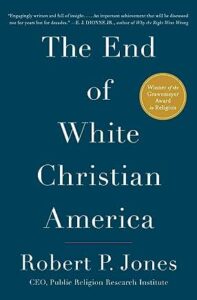 Summary: The era of White (Protestant) Christian cultural, political, and demographic dominance of the United States is over.
Summary: The era of White (Protestant) Christian cultural, political, and demographic dominance of the United States is over.
The starkness of the message of The End of White Christian America is as clear as its cover. Demographically (and this is shared in detail), the United States is no longer dominantly White Protestant. The more controversial suggestion that the political and cultural dominance of White (Protestant) Christians is also over is also hard to argue with based on the evidence presented, but many Christians have not yet accepted that.
Whether you accept the two of these suggestions will probably depend on your geographic and cultural place in the US. The demographics are clear. However, many White Protestants continue to live in communities that are racially isolated. Especially those that are in rural or suburban communities. Culturally, shifts toward acceptance of gay marriage, the aging of second-generation immigrant communities, and the significant increase in White Americans who do not identify as Christian (nones) have, at the very least, limited the cultural dominance of White Christians.
Robert Jones is the head of the Public Religion Research Institute. PRRI is a well-regarded polling company. Much of the research cited in The End of White Christian America is from PRRI polls. I generally trust PRRI to do decent work, but I can understand the complaint that there is not more outside research cited in the book (although there is some.) Despite the heavy number focus, The End of White Christian America is quite readable. It is essentially public polling and demographic data combined with recent (mostly 20th and 21st century) cultural and religious history. The cultural and religious history is mostly done fairly well, but as with any historical accounting, there is room to quibble with the conclusions.
The most controversial part of The End of White Christian America, in my mind, is about the shift in attitudes toward gay marriage in particular and the theological understanding of homosexuality in general. The polling on this is clear. The shift toward acceptance is complete. Even within Evangelicalism, there is a large minority that either politically or theologically accepts gay marriage as a good. Outside of Evangelicalism, it is not a large minority but an actual majority. Jones makes the argument that the Evangelical church needs to both accept they have lost this battle and to accept the full integration of gay Christians into the church formally. I hope that won’t keep people from reading the book. Regardless of your theological convictions here, Jones is making a case that many others are also making, but primarily, Jones is making a demographic case, not a theological one.
I think the most important part of this book is the focus on White in the phrase White Christian America. Theologically, it is very hard not to defend the full inclusion of all minority groups within the church. And almost no one today actually makes that argument. But it was not long ago that the argument was formally made. The fact that the church has not fully dealt with that history has many ramifications for today. Whether you fully agree with the argument or not, the reaction against school integrations was one of the reasons for the shift toward political involvement within evangelicalism that gave rise to the Religious Right. I do think it was a less important reason than abortion, but it was a reason (as was opposition to the ERA).
The White church (both mainline and evangelical) still has a lot of work to do theologically and socially to come to real terms with the collusion of the White church with cultural racism. Jones is hopeful that change can be made. But it will not be easy. However, it is likely necessary if the church moves forward, even with a diminished role in cultural and political life.
A friend of mine asked for my reaction/takeaway on Twitter yesterday. So this is what I said in 140-character chunks.
1) Deal with real demographic change. Nothing to fix about it. It is real, nostalgia won’t bring back dominance.
2) There is a real shift in attitude between generations. Gay marriage, esp, has a significant shift between older and younger believers.
3) Understanding the bad racial history of the White Christian church matters. If you can’t deal with it, you can’t move past it.
4) Get white Christians out of their bubble. 86% have no significant non-white friends. Having real friendship changes people.
5) The cultural dominance of white protestant Christianity will not come back. Coming to understand a new place in culture is the next step.
I do not think those steps are easy. But I do think dealing with them is essential to moving forward as authentic representatives of Christ in the United States in the near future.
One thing I thought was fascinating but didn’t really fit anywhere in the review is how quickly the demographics of the US have shifted. Between 2004 and 2012, there was a real shift in the electorate. If the population of the US were the same in 2012 as it was in 2004, Romney would have won the election. However, the demographic shift toward a slightly younger and less white demographic meant that focusing on the traditional White Male Christian as the base of the GOP was no longer a winning strategy, regardless of turnout. Romney and his advisors really thought they were going to win on turnout even though the polling numbers were against them because they thought they were in a 2004 demographic. They were not.
The End of White Christian America by Robert P Jones Purchase Links: Hardcover, Kindle Edition, Audible.com Audiobook